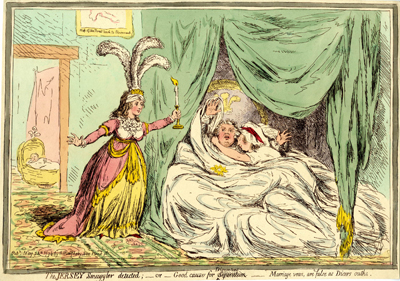The Jersey Smuggler Detected. . .
This print shows the Princess of Wales (Caroline of Brunswick), candle in hand, discovering her husband in bed with one of her housefold staff, the Countess of Jersey.

©Trustees of the British Museum
The marriage between the Prince and Princess of Wales had been troubled since the day it was arranged. Before that, the Prince had never met his future wife and only consented to marry Caroline in order to get his debts paid off. In an act of incredible bad faith, he had made sure that his current favorite mistress, Lady Jersey, would be part of the household as one of the (appropriately named) Ladies of the Bedchamber. And once Caroline had produced the obligatory heir (Charlotte Augusta seen in the crib in the background), the Prince wanted nothing more to do with her. The separation alluded to in Gillray's title was the inevitable result.
The Princess was a popular figure with the public (hence the lack of caricature in her portrayal here), and most people laid the blame for the separation squarely on Lady Jersey and the Prince. Jersey was one of the channel islands where an illicit trade with France was carried on at the time, so it was natural enough for Gillray to portray the Countess as a "Jersey Smuggler." A similar, unflattering analogy is set up for the Prince. Like Gertrude in Hamlet Act III, Scene 4, the Prince's marriage vows are shown here to be as "false as dicer's oaths," and the Prince's adulterous relationship with the already married Lady Jersey represents a stooping as egregious as Gertrude's in marrying Hamlet's abhorred uncle.
In spite of all this, most of the public were hoping for an end to the separation, and, in fact, within three weeks of the publication of this print, the Evening Mail announced that the Earl and Countess of Jersey had "resigned their situations at Carlton House," paving the way for a reconciliation. But as the print on the wall the wall above Caroline suggests, the "Road Back to Brunswick" would be circuitous at best and would necessarily involve a renewal of sexual relations.
This is one of two prints on the relationship of the Prince with Lady Jersey published in two days. By now, however, Gillray was the absolute master of the etching needle, sketching as quickly as any other artist with a pen. Shadows and contours in the print are created without roller or aquatint entirely freehand. And yet every stroke works with an amazing freedom and perfect control.
Sources and Reading
- Commentary from the British Museum on The Jersey Smuggler Detected. . .
- "George IV of the United Kingdom," Wikipedia
- "Caroline of Brunswick," Wikipedia
- "Sarah Villiers, Countess of Jersey," Wikipedia
Comments & Corrections
NOTE: Comments and/or corrections are always appreciated. To make that easier, I have included a form below that you can use. I promise never to share any of the info provided without your express permission.